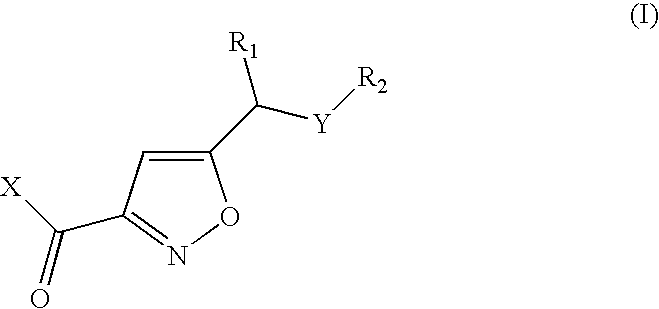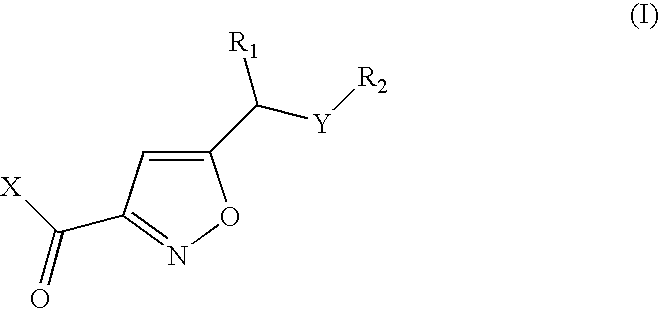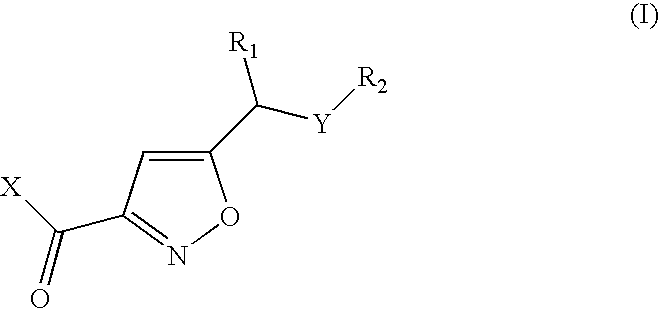Isoxazoles as peptide deformylase inhibitors
a technology of isoxazoles and inhibitors, which is applied in the field of isoxazoles as peptide deformylase inhibitors, can solve the problem that new pathways are not being targeted in a manner that outpaces the growth of bacterial resistan
- Summary
- Abstract
- Description
- Claims
- Application Information
AI Technical Summary
Benefits of technology
Problems solved by technology
Method used
Image
Examples
examples
Materials and Methods
[0129] The starting materials used herein are commercially available or can be prepared according to procedures previously reported in the literature. Unless otherwise stated commercial starting materials were used without further purification. All solvents were HPLC grade. Anhydrous solvents were obtained by storing over 4 Å activated molecular sieves. Synthetic methods to prepare the compounds of this invention might employ protective groups to mask a reactive functionality or minimize unwanted side reactions. Such protective groups are described generally in Green (1981).
[0130] NMR data were acquired on a Bruker Advance DRX 250. CDCl3 is deuteriochloroform, DMSO-d6 is hexadeuteriodimethylsulfoxide, D2O is deuteriooxide, acetone-d6 is hexadeuterioacetone and CD3OD is tetradeuteriomethanol. Abbreviation for NMR data are as follows: s=singlet, d=doublet, t=triplet, q=quartet, h=heptet, m=multiplet. Chemical shifts are reported in ppm, relative to internal sol...
examples 1-18
were prepared by following the General Method A.
General Method B (Scheme B).
[0135] Intermediates obtained from Step 2, Scheme A (0.1 mmol) were dissolved in MeOH (1.5 mL) and 1N NaOH (0.5 mL, 0.5 mmol) was added. Stirring was continued at room temperature for 1 h, until no more starting material was visible on TLC. 1N HCl was added until pH 2 and the water phase was extracted with EtOAc. The collected organic layers were washed with NaCl, dried over Na2SO4 and concentrated to dryness. In most cases analytically pure products were obtained without need of further purification. Otherwise, recrystallization from heptane / EtOAc or purification by preparative HPLC afforded analytically pure products.
[0136] Examples 19-32 were prepared by following the General Method B.
General Method C (Scheme C).
[0137] Step 1: Intermediates obtained from Step 2, General Method A (1 mmol), were dissolved in dry DCM, and m-CPBA (690 mg, 2.5 mmol) was added in one portion. Stirring was continued at roo...
examples 33-37
were prepared by following the General Method C.
General Method D (Scheme D).
[0138] Step 1: Intermediates obtained from Step 2, General Method A (1 mmol) were dissolved in glacial AcOH (8 mL) and NaBO3.H2O (229 mg, 1.5 mmol) was added in one portion. Stirring was continued at room temperature for 1-3 h, monitoring the reaction by ES-MS and TLC. A saturated solution of NaCl was added, extracted 3 times with EtOAc. The collected organic layers were dried over Na2SO4, filtered and concentrated to dryness. Purification by flash column chromatography afforded the expected products.
Step 2: Same procedure as in Step 3, General Method A.
Example 38 was prepared by following the General Method D.
General Method E (Scheme E).
[0139] Step 1: Intermediates obtained from Step 1, General Method C (0.5 mmol), were dissolved in THF (5 mL), cooled to −30° C. and NaH (0.6 mmol) was added in one portion. After stirring at low temperature for 15 min, an electrophile (1.5 mmol, for example MeI, EtB...
PUM
| Property | Measurement | Unit |
|---|---|---|
| Mass | aaaaa | aaaaa |
| Mass | aaaaa | aaaaa |
| Mass flow rate | aaaaa | aaaaa |
Abstract
Description
Claims
Application Information
 Login to View More
Login to View More - R&D
- Intellectual Property
- Life Sciences
- Materials
- Tech Scout
- Unparalleled Data Quality
- Higher Quality Content
- 60% Fewer Hallucinations
Browse by: Latest US Patents, China's latest patents, Technical Efficacy Thesaurus, Application Domain, Technology Topic, Popular Technical Reports.
© 2025 PatSnap. All rights reserved.Legal|Privacy policy|Modern Slavery Act Transparency Statement|Sitemap|About US| Contact US: help@patsnap.com



